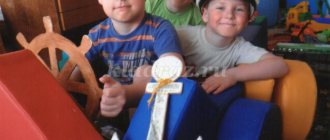Creative games for preschoolers: role-playing, directing, construction, theatrical
Kovaleva Alena
Creative games for preschoolers: role-playing, directing, construction, theatrical
for preschoolers include role-playing , directing ,
construction , theatrical .
Role-playing game is a creative game for preschool children
age, in its developed form represents an activity in which children take
assume the roles of adults and in a generalized form in specially created
game conditions reproduce the activities of adults and the relationships between them. The main source that feeds children's role-playing play is the world around them, the life and activities of adults and peers.
The main feature of a role-playing game is the presence of an imaginary situation in it. A distinctive feature of an imaginary play situation is that the child begins to act in a mental, rather than visible, situation: the action is determined by thought, and not
subject. So one object is replaced by another (a chair replaces a car, because the thought in the game still needs support, allowing it to carry out the action required by meaning.
The imaginary situation consists of a plot and roles that children take on during the game , and includes the unique use of things and objects. Another characteristic feature of role-playing games is that they are created by the children themselves, and their play activities are of a pronounced amateur and creative nature .
The amateur nature of play activity is that children independently choose the topic, time, place, line of its development, decide how they will reveal the roles, and the like. Each child is free to choose the means of embodying the image. Realizing your plan,
the child uses imagination and fantasy. This allows him to independently engage in those areas of human activity that in real life will be inaccessible to him for a long time. By uniting in a role-playing game , children themselves choose their partners, set the game rules themselves, monitor their implementation, and regulate relationships. In the game, the child reproduces his vision, his attitude towards the event that he is acting out.
The creative nature of play activity is manifested in the fact that the child, as it were, transforms into the person he is portraying, and, believing in the truth of the game , creates a special play life, sincerely expressing emotions in
progress of the game . The creative nature of the role-playing game implies ...
the presence in it of a plan, the implementation of which is associated with active work
imagination, with the development of the child’s ability to display his
impressions about the surrounding world. Creativity when playing a role
the child takes on the character of reincarnation. Children show great ingenuity, selecting toys and objects necessary for the game , helping to fully realize the plan and better cope with the role.
The plot-role-playing game has its own specific structure. This
structure includes the following components: plot , content,
role, rules, game actions, game and real relationships, substitute objects, imaginary situation, game partner.
The plot is the main component of a role-playing game ; without it there is no
the most plot-role-playing game . plots reflect specific conditions
child's life. They vary depending on these specific conditions,
along with expanding the child’s horizons and getting to know the environment.
The child’s playful actions are one of the main means of realizing the plot . IN
In the story, children use two types of actions: operational and visual
— "as if"
.
The plot of the game consists of the following elements: action, characters,
subject situation. The plots vary in thematic content and
by structure. The thematic content of the stories depends on the specific
living conditions of children.
Depending on the number of elements and type of connection, there are
game plot structures :
1. Plots that include one character, one action in one
subject situation.
2. Plots that include several characters with the same
types of actions in one subject situation. The connection between the characters is determined by one objective situation.
3. Plots , including two complementary characters interacting in the same subject situation.
4. Plots , where, along with the functional interaction of characters
defined by the relationships between them.
The game action in form can be: subject-substituting,
depicting, denoting.
The plots and content are varied and classified into:
a) everyday games (family life, kindergarten)
;
b) games on the theme of labor ; c) games with
social themes.
plot construction by the gaming culture of that game.
the group of children in which he is included; gaming tradition.
The content of a role-playing game is what is reproduced
child as the main thing in human relations. In content
games express more or less deep penetration of the child into
relationships and activities of people. It can only reflect the external
side of human behavior - only what and how a person acts, or
a person's relationship to other people, or the meaning of human activity.
The child’s inclusion of one or another thematic content in the game,
determine the real life situations in which he finds himself. These
real life situations vary in the degree of its activity and
the nature of inclusion in them into 3 types:
- a situation in which a child actively acts on an equal basis with an adult (as
dad and mom, eats, dresses, washes himself);
- a situation in which the child is directly involved, but is
the object of adults’ actions directed at him (he is treated by a doctor, gets a haircut
hairdresser, driver driving a car, etc.);
- a situation where children are not included in the activities of adults, are not accepted into
her direct participation, or observe it from the side ( builders
build a house , the librarian gives out books, etc., or learn about it from
stories, fairy tales, TV shows.
All three types of situations provide food for children's play . However, mostly
a preschooler's play is associated with recreating a situation of the second type.
The content of the role-playing game is embodied by the child with the help of
the role he takes on.
The role is a means of realizing the plot and the main component
role-playing game.
The role that a child takes on during the game , D. B. Elkonin
calls the unit of the game , its center, it unites all aspects of the game .
For a child, a role is his playing position: he identifies himself with
any character in the plot and acts in accordance with
ideas about this character. The child takes over the task
any role under certain conditions:
- if the sphere of reality, which is reflected in the plot of the game , is already
familiar to him. Familiarity with reality is the main condition
the emergence of role-playing games ;
- if acquaintance with reality occurs in this way,
that at the center of it is a person, his activity;
- if as a result of this acquaintance the child develops
positive emotional attitude towards reality of an adult
person.
Throughout preschool childhood, role development in plot-role
the game comes from the performance of role-playing actions to role-images.
The game clearly highlights the preparatory stage: distribution of roles, selection
gaming material, sometimes its production. Compliance requirements
life logic applies to all actions and role behavior
participants. The number of people involved in the game increases to 5 - 6 children.
Selection of role-playing games
At 3–4 years old, children mainly play games that reflect
family relationships and everyday activities in the family (dressing, bathing, receiving
food, etc., events in the life of the family and kindergarten (guests, holiday, trip
to the dacha, etc.). The games reflect the experience of visiting a children's clinic,
shop, hairdresser. Children's play activities are predominantly
addressed to toys (doll, bear, etc., most often children play
nearby, performing similar game actions. Gradually the children begin
unite in a game based on common actions (cook dinner -
feed the dolls, bring bricks - build a garage for the car ).
The number of characters in the plot is usually small - 2 - 3 (mother - daughter -
daughter, they are united by common events.
Games for children aged 4–5 years are similar in theme to games for children , but in them
more complex events appear, the number of characters increases
story _ Gradually from reflecting events related to the nearest
environment, children move on to reflecting events based on indirect
experience (from adult stories, cartoons, books, etc., more widely
reflects the professional activities of adults (in kindergarten, in
clinic, store, etc.). Children from playing with a toy partner
gradually turning to games in which the game action is aimed at
peer partner (he is being “treated”
,
“fed”
, etc.).
Games for children aged 5–7 years are focused on reflecting events
social world, impressions received outside the walls of kindergarten,
plots of your favorite films and cartoons, books ( "Journey by Sea"
,
"Tour agency"
,
“Grocery hypermarket”
,
“Fruit
bistro ” and
etc.). Games appear that involve reflecting impressions of complex
social objects, – “Museum”
,
"
Theatre " ,
"Rescue Service"
, arise
fantastic stories in which various events are intertwined.
The number of events reflected in the plot , the number
characters in the game , the relationship between them becomes more complicated.
It is important that in role-playing games children master social
relationships with content that is attractive to modern preschoolers ,
which promotes the development of creative imagination and positive
colored relationships with peers.
Principles for forming a story game :
the teacher plays with the children;
unfolds the game in such a way as to highlight for children exactly
role behavior;
The child's role behavior is immediately oriented towards the partner.
P. G. Samorukova identified the main directions of pedagogical
Game Guides:
creative play content management ;
guiding the collective activities of children in play;
preserving the spontaneity of play , children's independence and
initiatives. Immediate (direct)
game management also allows
diversify the content of the game , the development of its plot , relationships
between child characters. Basic techniques: calling them a teacher
role for the child, introduction of a new role into the game, questions, advice, participation in
conspiracy to play (middle group, participation in preliminary planning
games (senior group)
.
Director's play.
Director's play is the pinnacle of preschooler play .
She allows him to fit into his “I”
many different images and
positions and thereby stimulates an objective assessment of one’s own and others’
actions.
It occurs at the turn of 3 years (2.6 – 2.8 years)
and is called
a mini-director's game .
This game is individual, in it the child learns to come up with a plot , create the context that is needed for development
plot . But for this to happen, the following conditions are necessary:
individual "place"
for
play , so that you can focus on
the toy and understand how to play with it;
small toys that are easy for the baby to handle and control,
feeling like an adult who can control everything;
special position of an adult (not a participant in the game , but an interested
spectator: What are you doing? And why? Where did you go? Who's waiting for you there? And
etc.).
The influence of an adult on the director 's acting of this period is manifested in
providing a variety of gaming material and special
interest in the baby's play activities.
Features of the development of children's director's play , highlighted by E.
Gasparova:
Fourth year of life:
The game based on the child’s direct experience (events that
he observed or took part in);
the plots are simple , most often they are short chains of familiar actions,
the number of characters is small, the relationships between them are defined
during the game ;
Each toy has a permanent role assigned to it, resulting from
figurative solution. The role is also determined by the plot of events . If the stories
are prompted by unfamiliar toys, the game falls apart (child
either refuses to play, or is limited to extra-plot ,
objective and practical actions, therefore such toys
used only when playing with adults). Toys must respond
children's experience.
plot events are the result of the child’s associative perception
the surrounding world. The plot develops based on emerging
associations, which determines its not always coherent development. This,
natural, and does not require corrections or adult intervention,
the ability to change the plot gives scope for creative
imagination.
speech is the main component of the director's game . For this age
characterized by descriptive-narrative speech, which includes
evaluative statements and a large number of onomatopoeias.
Role speech is rare.
in the director's play, not only the life experience of the child, but also the experience of his
game actions.
Fifth year of life:
the game is still based on , but not direct, personal, but
indirect;
plots are very complex and varied,
main and secondary characters are distinguished. Weaved into
personal experiences and information obtained from various sources;
plot development still occurs on the basis of emerging
associations more complex than in three-year-old children, it is more often associated with
popular children's poems;
the game is almost entirely accompanied by speech. On the background
descriptive statements appear role and evaluative
statements expressing attitude to what is happening in the game
events, often motivating them.
The director's play of middle preschool children is experiencing
the influence, on the one hand, of the child’s experience, on the other, of the experience of play
actions and relationships that he acquires in a joint plot-role-playing game .
The preparatory stage for director 's play is the play of dramatization based on works that have a plot .
A good technique is to invent and tell the task, and then show it
a fairy tale or an excerpt from a familiar story.
Director's game is a type of independent plot game with
small toys, during which the child controls the actions
toys that are used as people or objects.
E. E. Kravtsova identifies 4 moments characteristic of the director’s
preschooler games:
the child creates the plot ;
he himself comes up with what the object will mean;
thinks through movement in space, how the director organizes
mise-en-scène;
performs all roles or accompanies the game with an “announcer”
text.
Director 's play is one of the earliest types of children's play , also known as
completes the development of the game in childhood , absorbing all the achievements
other types of children's games. It is in the director's acting that the
all the features of a child’s imagination.
E. E. Kravtsova highlighted the most important conditions for the development of directorial acting
children, starting from early preschool age :
1. Saturation of the subject environment with multifunctional objects,
which can be very different depending on the situation: cubes
(preferably without a picture, boxes, large buttons, construction kit parts,
which contributes to the child’s development of the ability to perceive ambiguously
objects of the surrounding material world. In this case, it is better to refuse
items that have a direct purpose.
2. Using game tasks in a director’s
game, which contributes to the development of gaming skills, for example:
give the child a cube and ask him to “roll the car”
, pet them like
ironing If a task is difficult, you need to complete it
together with the child (take his hands in yours)
. Must be accompanied
task with sounds - hum, hiss;
unravel the meaning of pictures from children's books - come up with ideas for the picture
a simple fairy tale or story;
involve the child in completing the story shown
teacher, child inventing the beginning of a story for a joint
showing with an adult also helps develop imagination;
in the tasks “Create and show a fairy tale”
, “Show me what you saw on
walk", "Draw a cartoon"
and others the child learns to hear
partner's story, keep the plot , imagine.
The teacher is in the position of “spectator”
who asks for a child
explain certain actions, asks questions: “What did you say?”
, "Where
went?", "Is he good or bad?"
, encouraging role-playing and evaluative
speech.
3. Creating space for each child to play as a director , so
so-called houses - secluded places fenced off on all sides, with
using screens, scarves, folding books on the table. It may
be a sheet of paper, a table flannelgraph, shoe boxes,
covered inside with paper, with cut out holes of different shapes.
Theatrical games.
Theatrical play is an effective means of social-emotional, speech and artistic-aesthetic development
preschoolers . It is directly related to two types
activity – gaming and artistic, which determines its “milestone”
character (A. N. Leontyev)
.
Theatrical play as a type of artistic
activity involves the need to work in three areas:
perception of literary text;
development of special artistic and gaming skills;
independent creative activity of children .
A characteristic feature of theatrical play is its focus on
viewer. Work on organizing a theatrical game is being completed
performance and is carried out in stages:
At the first stage, work is underway to deepen the artistic
perception of a literary text in the unity of its content, semantic and emotional subtext and means of linguistic expressiveness. Conducted
introducing children to literary texts, conversations, viewing
illustrations in books, listening and discussing audio recordings. Deepening
the perception of a literary text is facilitated by the inclusion of its content in
visual, musical and speech activities of children. In senior
in preschool age, retelling from the perspective of a literary hero is effective,
which helps the child understand and feel hidden motives
actions of the heroes, “ finish ”
image through one’s own interpretation of it.
At the second stage, special gaming skills are developed:
the ability to convey images using verbal means (intonation,
linguistic) and non-verbal expressiveness. The main method is figurative play sketches aimed at developing the ability to convey character
the hero, his emotional state and his own attitude towards him. IN
In older preschool age, at this stage it is useful to use the K technique.
S. Stanislavsky “assumption”
, which helps the child deeper
perceive the text, “see”
,
“hear”
what is happening in it, stand on
the hero's position. For example: “Imagine as if you were alone in the winter
forest at night, like the girl from the fairy tale “Morozko”
to make you feel?
The third stage is aimed at developing the child’s creativity in
the process of mastering the playing positions of “spectator”
,
“artist”
,
“
screenwriter-director ” ,
“designer-costumer”
,
“artist”
. Among the ways
to achieve the task of this stage, it is possible to collectively draw a poster,
making invitations, modeling costumes or their elements.
It is important to develop speech creativity through improvisation on
themes of literary texts: advanced forecasting of subsequent ones
events, combining well-known literary plots to create
new text, putting forward fantastic hypotheses.
Gradually, children naturally master the skills
necessary to participate in the performance, excluding special
learning roles. Creativity in independent play and speech
activity is stimulated by a specially created subject environment.
Construction games.
The meaning of construction games is determined by the following:
in the process of construction games, children learn to observe, distinguish,
compare, correlate some parts of buildings with others , remember and
reproduce construction , focus on
sequences of actions;
children develop intelligence and imagination (how to build )
;
in collective construction games, children acquire communicative skills
and technical skills;
children’s ideas about the world around them expand;
the child reflects the professional activities of adults
(builder)
;
promote the development of small muscles of the hands and the eye; constructing
constructions from large parts , children make physical efforts available to them
effort, showing endurance;
children will learn about the properties and qualities of building materials and their
features;
Children learn the correct use of relative concepts:
big - small, long - short, high - low, wide -
narrow;
develop constructive thinking and enrich speech.
The main content of the construction game is a reflection of the environment
life in different buildings and related activities. She's different
from constructive activity with its result - construction is not a goal , but
a means of developing a game image. Construction game to some extent
has much in common with a role-playing game and is considered as its
variety. Both species have one source - the surrounding life.
Construction often arises in the process of role-playing games and
caused by it. It kind of sets the goal for the construction game . To play
"Mothers and Daughters"
furniture is needed, to develop
a director's play based on
fairy tales, you need to build a fairy-tale village, etc.
Various materials are used for construction
specially created building material (floor, tabletop,
various constructors);
natural material (sand, clay, snow, stones)
;
auxiliary materials (boards, boxes, boxes, etc.)
.
The construction of a building and the making of a toy is what the game is all about: children
They agree on what they will build , in what ways, and distribute roles.
To develop constructive skills and children’s interest in
construction games , the teacher uses various techniques:
the teacher builds himself in the presence of children of primary preschool age ,
involves them in playing out the building ;
co-creation - invites children to complete , rebuild , transform
the building he built;
acquaintance with construction in reality (on walks,
during excursions, draw children’s attention to the features of various structures,
introduce construction equipment and the work of builders );
demonstration by the teacher of a sample building ;
construction methods with explanation of design techniques;
formulation of a problem problem (for example, how to rebuild a garage so that
it fits 2 - 3 cars);
message about the construction indicating the conditions (for example, build
room for a family with a certain number of people).
When working with preschoolers, various types of construction are used:
design based on a sample - the most common type
construction, allowing children to master general methods
actions, understand the sequence of operations;
designing on a given topic leads the child to creativity
implementation of the task, but the scope of its solution is limited
topic;
design according to one’s own design is a complex type in which
the child solves all problems independently: sets a goal
activity, plans it, selects the necessary material, implements
intention;
construction according to conditions - carried out after children learn
build this or that object, building, certain parameters are set
buildings that the child must take into account;
construction using models - the child is offered a model of the building (drawing,
a building made by a teacher , covered with paper on which
the outlines of the constituent elements of the structure are hidden. Child
first analyzes the model: identifies its component parts, then selects
those forms that are needed to recreate the model.
Online Games
1
Catch the cat. A game
Catch the Cat is a great game for testing your ability to solve non-standard problems, as well as a good opportunity to practice your skills in finding creative solutions. This online flash game was developed by the famous Japanese design laboratory Gamedesign (gamedesign.jp) and has the original name “Chat Noir” (“Black Cat” in French). Play
2
Droodles
The essence of the game is that you are asked to describe a picture that has multiple meanings. A doodle picture is something like a scribble and is similar to what a student or schoolboy usually draws mechanically on paper during a lecture or lesson. However, in droodle, the authors initially provide for the variability of its interpretation. Try to use your creativity in solving doodles.
3
IQ Ball
“IQ Ball” is an interesting online flash game that is perfect for both children and adults. By playing it, you will learn how to find non-trivial and most effective solutions, which is necessary for any person who wants to develop their creative skills. Play.
4
Memory Matrix
The game “Memory Matrix” is well known to everyone from applications for Nokia phones. There are also many analogues for different platforms. Here we invite you to play the classic version of this simple flash game, which is great for training memory and concentration, which is also important for developing creativity. Play.
5
8 queens
8 queens is one of the most famous chess problems. Finding an answer to the question of how to place 8 queens on a chessboard at the same time will be useful for everyone who wants to develop their intellectual abilities, find solutions to non-standard problems, and think through moves in search of an answer. After all, even in this seemingly logical chess puzzle, all the answers can only be found with the help of a creative approach. Play.






